
Au-Haidhausen (Central Bavarian: Au-Haidhausn) is the 5th borough of the German city of Munich, Bavaria. It is formed by the Au and Haidhausen districts.

Au-Haidhausen (Central Bavarian: Au-Haidhausn) is the 5th borough of the German city of Munich, Bavaria. It is formed by the Au and Haidhausen districts.
Au lies opposite the Altstadt of the city on the easterly plain tract of the Isar. Haidhausen is above Au on the Isar's uplands. Au-Haidhausen borders Bogenhausen to the north, Berg am Laim to the east, Obergiesing to the south, level with the flow of the Isar at Untergiesing, ending in the west at the river.

Au and Haidhausen used to be hostel areas for trade workers and day labourers outside of the medieval town walls of Munich. Both formerly independent municipalities were incorporated into the City of Munich on 1 October 1854 and developed into suburbs during the Gründerzeit. Many breweries were located on the high banks of the Isar, thus right on the edge of the terrace. These were good locations for deep natural water sources and beer cellars; for this reason, the name "Keller" (cellar) is still used to refer to the brewery-restaurants nearby. Near Rosenheimer Platz on Rosenheimer street stood the Bürgerbräukeller, the location of the first assassination attempt on Adolf Hitler. Today, one of the largest breweries in Munich can be found there: Paulaner, in Au. Nearby, the Gasteig marks the transition to the inner city, a cultural center which hosts the Munich Philharmonic Orchestra, parts of the University of Music and Performing Arts Munich, the Volkshochschule, Munich's municipal library and important events such as the Filmfest München and the Munich Biennale.


Even though the structural integrity of buildings in Au was heavily compromised during the Second World War and only a fifth of buildings dated before 1919 still stand, the historical townscape of Haidhausen remains largely intact. Of high constructional significance is the Franzosenviertel ("the French quarter"), so called because of given street names to locations of victory in battles of the German-French War. The existence of good condition housing lead to Haidhausen becoming the second largest area of redevelopment in the 1970s, alongside Schwanthalerhöhe. This property redevelopment and revaluation triggered by the upgrade of accommodation lead to not only restructuring of a suburb to the outskirts of the area, but also a change of image, thus putting Haidhausen in competition with Schwabing as a trendy area to live in Munich.
The balanced mixture of accommodation and living in Au and Haidhausen has shifted towards housing; this is due to the outsourcing of otherwise bothersome trades. Most jobs in the district lie in service industries and other public areas.
Haidhausen accommodates the Bayerische Landtag in the Maximilianeum, the Klinikum rechts der Isar and the Wiener Markt. On the northern border the Friedensengel ("peace angel") towers above the city on the Isar plateau. If one follows Prinzregentenstraße from there to the east, around 100 metres along on the right hand side is the Villa Stuck, that the "Malerfürst" ("Painter prince") Franz von Stuck allowed to be constructed according to his own blueprints. As of 2004 the entirely reconditioned buildings of the Villa and the former studio is now an art museum. Further east down Prinzregentenstraße lies the Prinzregententheater, one of the most striking Art Nouveau theatre buildings in Germany; adjacent to which is the Prinzregentenstadion, which serves as a popular ice skating venue in winter. With the Maria-Theresia-Gymnasium in the south the district also accommodates one of the few German Schools of Excellence.
With the Auer Dult taking place three times per year at the Mariahilfplatz, and the tapping of Bock at the Nockherberg in the Salvatorkeller of the Paulaner brewery on the Hochstraße (High street), rebuilt after heavy fire damage, Au has a significant amount of traditional daily culture.
(As of 31 December, Inhabitants with principal residence)
| Year | Inhabitants. | of which Foreigners | Area (ha.) | Inhabitants per ha. | Source |
|---|---|---|---|---|---|
| 2000 | 52,028 | 13,257 (25,5%) | 421.75 | 123 | Statistisches Taschenbuch München 2001. pdf-Download |
| 2001 | 51,947 | 12,954 (24.9%) | 421.75 | 123 | Statistisches Taschenbuch München 2002. pdf-Download |
| 2002 | 52,000 | 13,007 (25%) | 421.75 | 123 | Statistisches Taschenbuch München 2003. pdf-Download |
| 2003 | 51,636 | 12,759 (24.7%) | 421.75 | 122 | Statistisches Taschenbuch München 2004. pdf-Download |
| 2004 | 51,383 | 12,307 (24.0%) | 421.78 | 122 | Statistisches Taschenbuch München 2005. pdf-Download |
| 2005 | 52,502 | 12,322 (23.5%) | 421.79 | 124 | Statistisches Taschenbuch München 2006. pdf-Download |
(Statistical Pocket Book Munich)
Helmuth Stahleder: Von Allach bis Zamilapark. Names and historical dates of the history of Munich and its incorporated suburbs. Stadtarchiv München, ed. München: Buchendorfer Verlag 2001. ISBN 3-934036-46-5

Munich is the capital and most populous city of the Free State of Bavaria, Germany. With a population of 1,594,632 inhabitants as of 31 May 2024, it is the third-largest city by population in Germany, after Berlin and Hamburg, and thus the largest which does not constitute its own state, as well as the 11th-largest city in the European Union. The Munich metropolitan area - including suburbs and satellite towns - has 3 million inhabitants; and the city's metropolitan region is home to about 6.2 million people and is the third largest metropolitan region by GDP in the European Union.

Märzen or Märzenbier is a lager that originated in Bavaria, Germany. It has a medium to full body and may vary in colour from pale through amber to dark brown. It was the beer traditionally served at the Munich Oktoberfest. The geographical indication Oktoberfestbier is protected in the EU and can only be used for Märzen that is brewed in Munich.

The Hofbräukeller is a restaurant in Haidhausen, Munich, Germany owned by Hofbräuhaus brewery. This restaurant serves the traditional Bavarian cuisine and is less touristy than Hofbräuhaus am Platzl and more popular with the locals. It is a part of the Wiener Platz, home to the Wiener Markt.
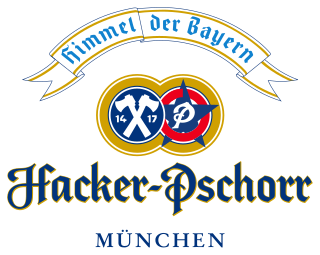
Hacker-Pschorr is a brewery in Munich, formed in 1972 out of the merger of two breweries, Hacker and Pschorr. Hacker was founded in 1417, nearly a century before the enactment of the Reinheitsgebot beer purity law of 1516.
The Bürgerbräukeller was a large beer hall in Munich, Germany. Opened in 1885, it was one of the largest beer halls of the Bürgerliches Brauhaus. Bürgerliches merged with Löwenbräu, which thereby became the hall's owner.
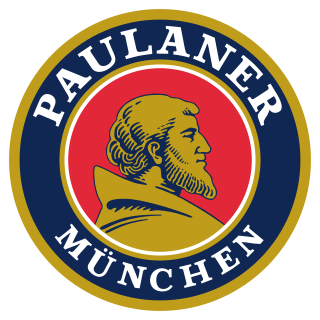
Paulaner is a German brewery, established in 1634 in Munich by the Paulaner Order of mendicant friars. Now owned by the Schörghuber family, it is one of the six breweries which provides beer for Oktoberfest. Paulaner ranks number six among Germany's best-selling beers.
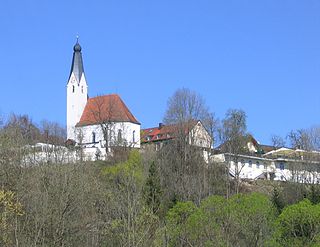
Pullach, officially Pullach i. Isartal, is a municipality in the district of Munich in Bavaria in Germany. It lies on the Isar Valley Railway and is served by the S 7 line of the Munich S-Bahn, at the Großhesselohe Isartalbahnhof, Pullach and Höllriegelskreuth railway stations.
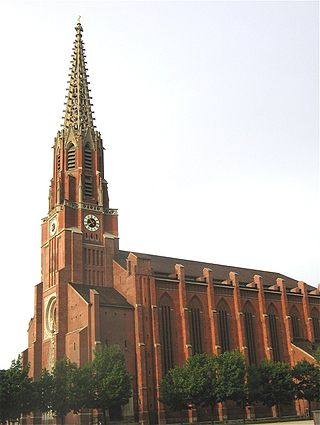
The Mariahilfplatz is a town square on the right bank of the River Isar in the district of Au in Munich, Germany.

Bogenhausen is the 13th borough of Munich, Germany. It is the geographically largest borough of Munich and comprises the city's north-eastern quarter, reaching from the Isar on the eastern side of the Englischer Garten to the city limits, bordering on Unterföhring to the north, Aschheim to the east and the Haidhausen borough to the south.

Altstadt and Lehel are districts of the German city of Munich. Together they form the first borough of the city: Altstadt-Lehel.

Au is a district in the south eastern plain tract of the German city of Munich in Bavaria. Au extends from the Deutsches Museum in the north and along the Isar up to Wittelsbacherbrücke in the south.

This article gives an overview about the architecture of Munich, Germany.
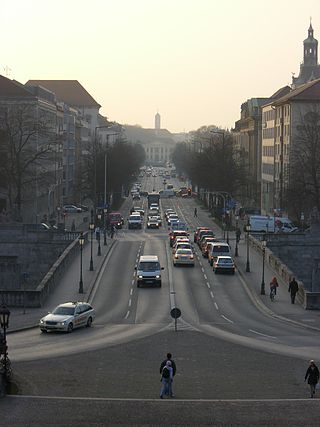
The Prinzregentenstraße in Munich is one of four royal avenues and runs parallel to Maximilianstraße and begins at Prinz-Carl-Palais, in the northeastern part of the Old Town. The avenue was constructed from 1891 onwards as a prime address for the middle class during the reign of Luitpold, Prince Regent of Bavaria and is named in his honour. The square in the eastern part of the street is named Prinzregentenplatz.
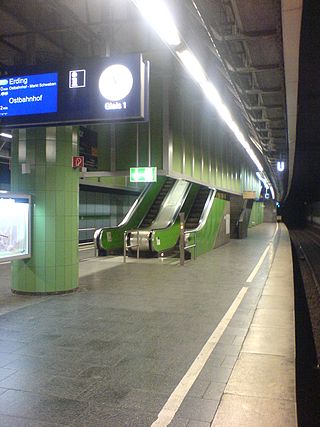
Munich Isartor station is a station opened in 1972 on the Munich S-Bahn on the trunk line between Munich Central Station and Munich East station (Ostbahnhof). It is located below Isartorplatz and the Thierschstraße/Zweibrückenstraße intersection in Munich and is named after the nearby Isartor city gate. It is classified by Deutsche Bahn as a category 4 station.

Haidhausen is a quarter in Munich, Germany. It is now part of the borough of Au-Haidhausen.
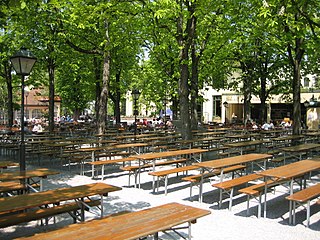
Nockherberg is the name of a small terrace on the slope of the eastern bank of the Isar in Munich, situated in the urban district of Au. An annual beer festival rich in tradition takes place there in the Paulaner Brewery - the Salvator-Ausschank auf dem Nockherberg The name of the raised terrace is often used synonymously for this festival or its opening event, the tapping of the first barrel of a strong, seasonal beer (Starkbieranstich).

The Nockherstraße is a road located in the south of Au-Haidhausen, the 5th district of Munich, Germany. The former suburb of Au is located in the original flooding area of the Isar. The 500-meter-long road runs between the end of the Ohlmüllerstraße and the Kolumbusplatz at the foot of the Isar river terrace. About 400 people live in Nockherstraße.

The Ismaninger Straße is a city center, entrance and exit road in Munich.

Englschalking is a quarter of the Bavarian capital Munich and belongs to the district 13 Bogenhausen.